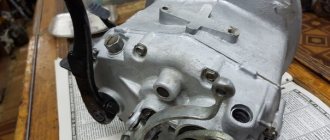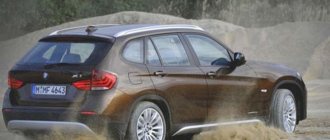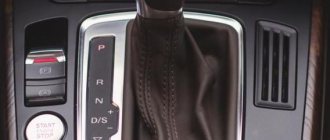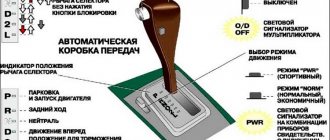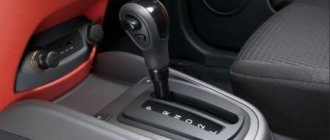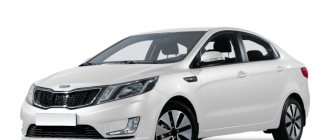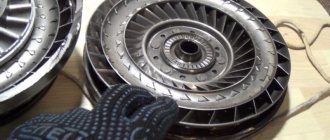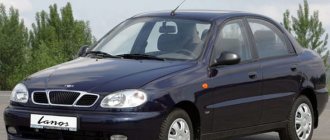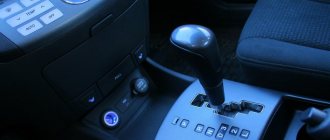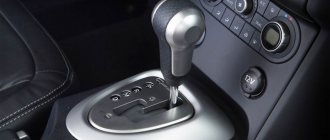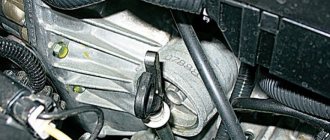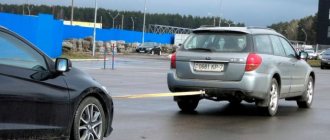When the time comes to learn to drive, many students are faced with the question of which automatic transmission to learn to drive. There is an automatic transmission and a manual transmission. So what are these letters? Automatic transmission - what it is is not entirely clear. This is nothing more than the ability to drive a car in automatic mode. The driver can only learn to decipher the symbols on the automatic transmission, which are located on the panel near the mode switch lever. Today we will look in detail at what the letters on the automatic transmission box mean.
What is an automatic transmission
An automatic transmission is essentially a transmission. Automatic Transmission The abbreviation is as follows - Automatic Gearbox. Switches speed modes (increasing and decreasing speed) without driver intervention. The person behind the wheel can only set the direction and use the gas and brake pedals (there is no clutch pedal), and then steer.
The clutch is performed by the gearbox itself. The automatic transmission also selects the right moment to change speed. Gears shift without jerking, smoothly. Driving a vehicle is greatly simplified, unlike mechanics, which are completely controlled by the driver. Manual transmission decoding - Manual Gearbox. Transmission option decoding – Gearbox. Switching is performed by a mechanical drive.
Designation of gearbox types
Different types of automatic transmissions have different names from each other, which are contained in easily recognizable abbreviations. Knowing what the letters mean, you can understand from the car manual which gearbox it is equipped with and what it is capable of. In modern cars there are:
- CVT or Continuous Variable Transmission, or simply “variator”. It features continuously variable gear shifting. The boxes operate very smoothly, but their reliability is somewhat lower than that of conventional automatic machines.
- DSG, or Direct Shift Gearbox. This gearbox is robotic and has two clutches. It is based on a manual gearbox, improved by an electric control module and servos, with the help of which gears are changed.
- AT or automatic transmission. It is a classic hydromechanical design. It is very reliable, as it is time-tested.
- MTA or Manual Transmission Shifted Automatically, or "robot". The name speaks for itself - this gearbox is completely robotic. It doesn't have a clutch pedal.
What these or those letters mean can be found out both from the manufacturer, seller, and in open sources on the Internet. Don't act at random when driving a new car. It is better to familiarize yourself in detail with the capabilities of the existing gearbox in order to use it correctly in the future 100%.
Automatic transmission modes
In an automatic transmission, as in a manual transmission, there are several speed levels. The lever switches functionality - modes. We have already found out how the gearbox is deciphered, now let’s look at the modes and their letter designations:
- N (Neutral) – neutral. Position without speeds. The mode is used when towing a car, for example. Some drivers, when stuck in traffic jams, put the lever in the neutral position, because keeping your foot on the brake pedal for a long time is not very comfortable;
- D(Drive) or A (Automat) – movement. By moving the lever to this mode, the driver begins to move, the car starts moving and all he has to do is steer and press the pedals;
- R (Revers) – reverse gear. The position is used to move the vehicle in reverse. It turns on only after a complete stop. While driving, it is strictly prohibited to move the lever to mode D;
- P (Parking) – stop. After stopping movement, the lever is placed in position P. This guarantees that the car will not roll, because the mode blocks the wheels. It is forbidden to turn on while driving. In most models, the engine will not start if the lever is not set to P mode;
- M (Manual) – manual control. The driver can change gears himself using the “+” and “-” buttons located on the lever or on the steering wheel. Different models vary;
- L (Low) or l; 1; 1L – slow. In this position, the car will only move in first gear. It is also used on slippery roads, steep descents and ascents, or for engine braking;
- L2, 2L or just 2 – in this mode, driving will be limited to the second speed and will not switch higher;
- D3 or number 3 – movement no higher than third speed;
- D4 or 4 - the car will shift to fourth gear. It will not go to 5 and 6;
- OD (Over Drive) – overdrive. The mode is activated by a button at a speed of at least 75 km/h. Providing stable driving on the highway, it saves fuel;
- KD (Kick Down) – low gear. It turns on itself if you squeeze the gas all the way. Helps to quickly gain speed;
- B (Block) – differential lock. Found on all-wheel drive vehicles and jeeps. Used when driving on rough terrain, off-road;
- S (Sport) – sporty. The mode uses engine power to its fullest. In this position, it becomes possible to accelerate the car sharply. More fuel is burned than usual;
- E – savings. On the contrary, fuel is used sparingly because the position ensures smooth movement;
- W (Winter) or snowflake - winter. When in the on position, slipping on ice is eliminated. The car starts at 3-4 speeds, then switching them at lower speeds and leveling out the acceleration difference. Cannot be used in summer to avoid overheating of the torque converter.
In different models of cars with automatic transmission, other designations may also be found. You should always read the instructions and manuals carefully.
What do the letters on the automatic transmission mean or the meaning of the buttons on the automatic transmission lever?
Such buttons can be either on the shift knob itself or near it:
- OD - or known as (Over Drive) is similar to mode 3 or D3 - made so that when driving, for example, at a speed of 60-80 km/h, your transmission constantly clicks, switching from 3 to 4 and vice versa from 4 to 3 gear, so that this did not happen, turn on the OD , in fact, this mode automatically activates mode 3, which means you will move in 3rd gear
- M - translated as Manual, that is, manual control, you can choose when to turn on and what speed to turn on in your car, this is usually done with the + and - buttons either on the speed lever or on the steering wheel or with the paddles behind the steering wheel or under the steering wheel
- S – or otherwise (Sport) not all gearboxes are equipped with it, sport mode implies more active movement and speed gain, which, of course, will affect fuel consumption
- W or Snow sometimes also draw a snowflake - which means (Winter) in our winter mode, puts the box into a very smooth starting mode so as not to shovel snow under you and sit on your belly
- E – can be translated (Economic) as economical, the car will not be too playful, but fuel will be consumed significantly less
- KickDown - or “gas to the floor”, many have probably heard this expression, it exists so that when the gas pedal is pressed sharply and all the way to the floor, the box switches to one or two gears lower for a very quick increase in speed, used when overtaking or, when you don't have time to stop overtaking
How to start driving an automatic transmission
The driving theory is this. Driving a car with an automatic transmission starts with:
- Get behind the wheel and start the engine. The indicators on the panel should light up. The lever must be in position P or N. Wait 10 seconds, the fuel pump will turn on;
- Press and hold the brake pedal;
- Move the lever to position D.;
- Smoothly release the brake pedal. The car will immediately start moving. All you have to do is press the gas.
For reverse:
- Stop completely. Press the brake;
- Put the lever in R mode;
- Release the brake and start moving.
Automatic does not tolerate aggressive driving. It is recommended to ride smoothly. The electronics need time to switch, otherwise the engine will wear out faster. Repairing a machine gun is an expensive thing.
As you can see, operating the automatic transmission is simple, enjoyable and safe. To drive, you need to remember the letter designations of the modes, carefully study the manual for using a car with an automatic transmission, and off you go.
Designations
For those who have previously driven a manual car, the letter designations may not seem clear at first glance. However, it is not at all difficult to understand them, because the letters indicate the operating modes of the box, and the first letters of foreign words indicate the action that the driver is going to perform. There may be more or less, but we will now look at the main ones:
- P – parking mode;
- R – reverse;
- N – neutral gear;
- D – main mode, driving mode (in some cars this is “A”);
- Numbers from 2 to 4 – indicate movement in a gear not higher than one of the selected gears;
- L – low gear (in some car models this is “B”);
- M – mechanical gear shift, by moving the lever to “+” or “-”;
- S – sport mode;
- E – economical mode;
- W – winter mode (can be indicated by a snowflake, the word SNOW or HOLD). This mode cannot be turned on in summer, and often used in winter. The box may overheat and burn;
- OD – overdrive;
- KD – low gear, engages independently when you press the gas fully, provides a quick increase in speed.
These are just some of the symbols that you may encounter, and unlike a manual transmission, which you can learn to shift in a couple of days, you will need to become thoroughly familiar with an automatic transmission. The user manual will help you with this.
What kind of automatic machine is installed on the Hyundai Solaris
Until 2014, only the 4-speed A4CF1 automatic transmission could be installed on Solaris, regardless of engine size. Since 2009, the company, together with Mitsubishi, began developing and testing a new six-speed automatic transmission A6GF1, which replaced the outdated five-speed automatic. Initially, the new box was installed on the limited edition Hyundai Avante in HD/MD trim levels, and later the box went to the Sonata, Opirus, Kia Optima and several other cars, including the Hyundai Solaris.
4-speed automatic transmission A4CF1.
6-speed automatic transmission A6GF1.
According to official data, Solaris with a new 6-speed automatic transmission has become more economical, more dynamic and smoother, although the numbers do not always confirm this. With the Gamma 1.6 engine and manual transmission, the car consumes 6.1 l/100 km in the combined cycle.
Automatic transmission with pan removed.
According to company standards, the A6GF1 and A4СF1 gearbox index is deciphered as follows:
In some modifications of the A6GF1 automatic transmission you can find the index L, which means that the box is designed for a torque of at least 400 Nm when paired with a 2.4–3.8 liter diesel engine. The letter M indicates the ability of the automatic transmission to transmit up to 280 Nm of torque and work with gasoline and diesel engines with a volume of 1.6–2.4 liters.
Interpretation of automatic transmission markings A6GF1, A6MF1/2 and A6LF1/2/3.
The hydromechanical automatic machine on Solaris has a classic design - a torque converter, several planetary gearboxes, friction and overrunning clutches. Nevertheless, the A6GF1 automatic transmission has several features that distinguish it from other models:
The difference between the instrument panel and automatic transmission is a separate window with the gearbox operating mode.
At this time, the level and quality of the oil in the gearbox crankcase is checked, and its replacement should be carried out at a mileage of 80–100 thousand km, depending on the operating mode. ATF oil for all Solaris automatic transmissions is used in the SP4 standard in a volume of 7.3 to 7.8 liters. depending on the modification of the box. When changing the oil, it is necessary to replace the filter. The filter catalog number is 367010BC.
Solaris automatic transmission oil filter - catalog number 367010BC.
When changing the oil, replace the filter.
An automatic transmission oil change is carried out at a mileage of 80–100 thousand km.
The six-speed automatic transmission is very sensitive to oil quality and pressure. At a mileage of more than 140-150 thousand, as a rule, it is necessary to replace the repair kit of gaskets and seals. If you do not replace them in time, the solenoids may fail, which significantly increases the load. If the oil pressure is below normal (oil leakage, low level), there is a high probability of clutch failure. In such cases, it is necessary to use a complete repair kit with index 367007.
By timely servicing the automatic transmission on Solaris, you can achieve a long service life of the unit and proper, correct operation. Keep an eye on the oil level in the box and good luck to everyone!
Lesson 4. How to use an automatic transmission
In order to understand how to use an automatic transmission, it is enough to know what modes the machine has and how to turn them on. Therefore, we will consider the main and possible modes, as well as how to use them.
What do the letters on the box mean?
The most common, present on almost all automatic transmissions:
- P (Parkind) - parking mode, the car will not roll away either when it’s running or when it’s turned off;
- R (Reverse) — reverse mode (reverse gear);
- N (Neutral) - neutral gear (the car does not respond to gas, but the wheels are not blocked and the car can roll if it is standing downhill);
- D (Drive) - forward driving mode.
We have listed the standard modes of most automatic transmissions, but there are also more sophisticated, technologically advanced boxes with additional modes, let’s look at them:
- S (Sport) - the name of the mode speaks for itself, the transmission begins to change gears more sharply and quickly, in contrast to the usual comfortable mode (this designation may also have a different character - SNOW winter mode);
- W (Winter) H (Hold) * - winter modes that help prevent wheel slip;
- Selector mode (indicated in the photo below) - designed for manually shifting gears forward and backward;
- L (Low) - low gear, a mode typical for SUVs with an automatic transmission.
How to switch automatic transmission mode
On all automatic transmissions, standard modes should only be switched after the vehicle has come to a complete stop and the brake pedal is pressed.
It is clear that in selective (manual) mode you do not need to stop to change gears.
In the cabin
The main element of the automatic transmission with which the car owner interacts is the automatic transmission selector. It is used to switch transmission modes, and you should know the symbols on the automatic transmission in order to select the correct mode and understand exactly how the automatic transmission works at the moment. Mode designations are often duplicated on the dashboard of modern cars.
A typical selector with notation:
Let's look at the main symbols on the automatic transmission
Latin letter P: this is the beginning of the word Parking, indicating the parking/parking mode, which some car owners also call the parking brake.
In this mode, the vehicle's drive wheels are locked to prevent unintentional movement.
The letter R. The word Reverse begins with it, meaning movement in the opposite direction.
Selecting R on the selector engages the reverse gear of the box.
The letter N is a classic one, familiar to many from a manual “neutral” transmission.
In this mode, no force is transmitted to the wheels, but they themselves are not blocked.
This is the so-called Drive, the main mode of the box, in which normal movement is carried out.
Letter A.
Sometimes you see this designation instead of D, and it means the same thing - normal movement mode.
Designation on the automatic transmission L.
It indicates the engagement of a low gear (Low), which is useful for overcoming obstacles on the road. The engine braking function is activated to help the driver safely navigate steep descents.
- Digit 2: selecting this mode limits the maximum possible gear to the 2nd transmission stage.
- Number 3: a similar limitation, but the “ceiling” of gears is the third.
The letter M. This is an abbreviation for the word Manual, it is found on Tiptronic automatic transmissions and analogues equipped with the ability to switch to the so-called manual mode.
It allows the driver to manually change the gear ratio by moving the selector to a special section marked with “+” and “-” signs. Examples of such a box:
S – sport mode, characterized by a slightly optimized logic for changing transmission stages for fast movement.
Abbreviation OD.
This is the designation of an automatic transmission with an Overdrive, or “accelerated” mode.
W – winter, “Winter”, driving mode.
In it, the car starts moving from second gear to avoid slipping on snow and ice.
- E – fuel saving mode, Economy.
- The Hold button can have different meanings, usually it indicates a “winter” mode, similar to the W button.
It is mounted on the gearshift lever or placed on the dashboard:
On the automatic transmission lever there may be a designation of the type of gearbox installed in the car - for example, DSG, and the type of drive:
Next to the selector, additional function keys can be located that use various features of the car - opening the trunk, heated seats, etc. All of them are indicated by corresponding pictograms.
The main purpose of reduction gears
The design of the automatic is such that when a downshift is engaged in the automatic, more torque is transferred to the vehicle’s drive, which makes it easy to force through deep puddles, washed-out country roads and other difficult areas..
Whereas in normal automatic mode, the car simply will not have enough power and torque to get out of such a deep hole or swampy area.
With a manual transmission, the driver can regulate the power and torque that is transmitted to the drive wheels. Many SUVs also have a full reduction gear, which allows you to feel confident off-road. Before the advent of such reduction gears on automatic machines, it was extremely difficult to use cars on rough roads. However, today, owners of such cars can feel confident on country roads, confident that they will not get stuck in the first deep puddle.
